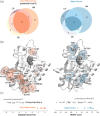Prediction of pyrazinamide resistance in Mycobacterium tuberculosis using structure-based machine-learning approaches
- PMID: 38500518
- PMCID: PMC10946228
- DOI: 10.1093/jacamr/dlae037
Prediction of pyrazinamide resistance in Mycobacterium tuberculosis using structure-based machine-learning approaches
Abstract
Background: Pyrazinamide is one of four first-line antibiotics used to treat tuberculosis; however, antibiotic susceptibility testing for pyrazinamide is challenging. Resistance to pyrazinamide is primarily driven by genetic variation in pncA, encoding an enzyme that converts pyrazinamide into its active form.
Methods: We curated a dataset of 664 non-redundant, missense amino acid mutations in PncA with associated high-confidence phenotypes from published studies and then trained three different machine-learning models to predict pyrazinamide resistance. All models had access to a range of protein structural-, chemical- and sequence-based features.
Results: The best model, a gradient-boosted decision tree, achieved a sensitivity of 80.2% and a specificity of 76.9% on the hold-out test dataset. The clinical performance of the models was then estimated by predicting the binary pyrazinamide resistance phenotype of 4027 samples harbouring 367 unique missense mutations in pncA derived from 24 231 clinical isolates.
Conclusions: This work demonstrates how machine learning can enhance the sensitivity/specificity of pyrazinamide resistance prediction in genetics-based clinical microbiology workflows, highlights novel mutations for future biochemical investigation, and is a proof of concept for using this approach in other drugs.
© The Author(s) 2024. Published by Oxford University Press on behalf of British Society for Antimicrobial Chemotherapy.
Figures





References
-
- WHO . Global Tuberculosis Report 2022. 2022. https://www.who.int/publications/i/item/9789240061729.
-
- Zhang Y, Mitchison D. The curious characteristics of pyrazinamide: a review. Int J Tuberc Lung Dis 2003; 7: 6–21. - PubMed
Grants and funding
LinkOut - more resources
Full Text Sources
Other Literature Sources
Molecular Biology Databases
